Physical Address
304 North Cardinal St.
Dorchester Center, MA 02124
Physical Address
304 North Cardinal St.
Dorchester Center, MA 02124

Discover 21 kitchen storage ideas perfectly suited for historical homes, balancing authentic character with modern functionality. Learn how to maximize space while preserving period details.
Your kitchen tells a story. In a historical home, it’s less a tidy narrative and more a sprawling epic—full of quirky chapters, unexpected plot twists in the form of wonky corners, and a cast of characters built from old-growth wood and stubborn horsehair plaster. I’ve spent the last 12 years helping homeowners navigate these stories, finding ways to honor the past without being held hostage by it.
Frankly, the biggest tension in any period renovation is between the romance of history and the reality of Monday morning. You love the charm of your 1920s kitchen, but you also need a place to put the blender and the recycling bin. The magic happens when we stop seeing these as conflicting goals. The solutions that follow aren’t just clever storage hacks; they are thoughtful ways to continue your home’s story, creating a space that works beautifully for the way you live now.
Before the 1950s and the obsession with uniform, wall-to-wall cabinetry, kitchens were fundamentally workrooms. And in a workroom, you keep your tools where you can see them. That’s why Open Shelving feels so right in many older homes—it’s not a trend, it’s a return to form. It’s also your single greatest weapon against a lack of cabinet space.
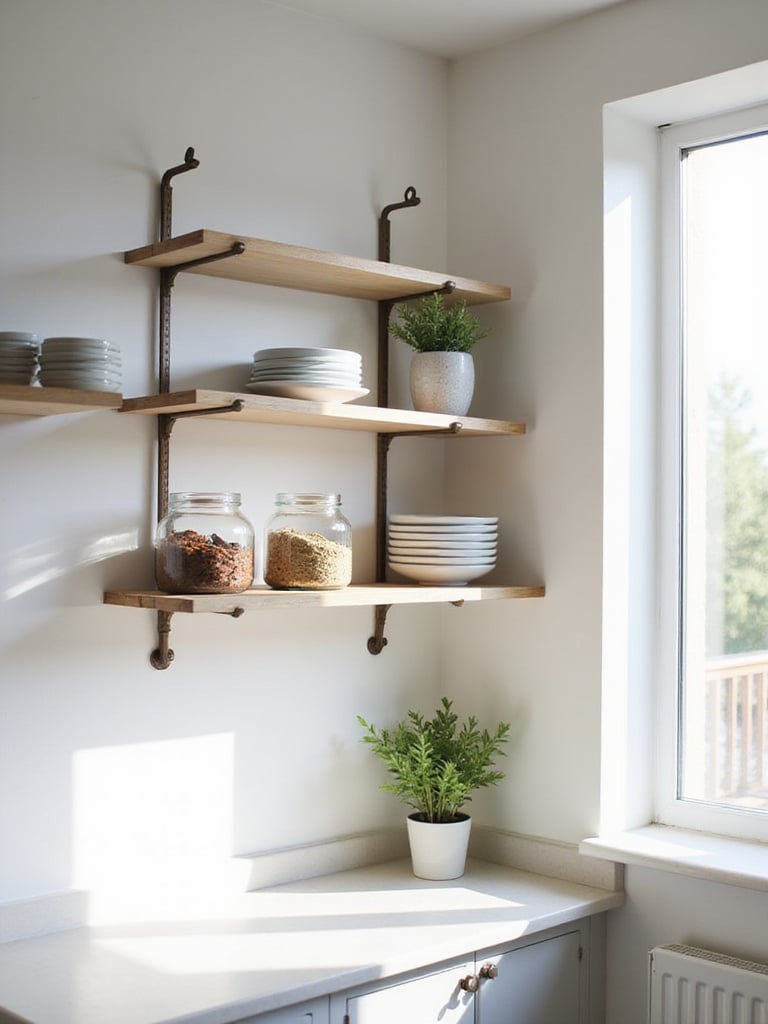
What I tell my clients is to look at their existing architecture for cues. For a 1910 Craftsman I consulted on, we sourced reclaimed quarter-sawn oak from a salvage yard—the grain matched the original built-in hutch perfectly. We mounted the new shelves on simple, unadorned iron brackets. The result? They tripled their storage for everyday dishes, and the new shelves looked like they’d been there for a century. The key is in the material and the hardware; get that right, and the shelves become a natural extension of the home’s character, not a modern imposition.
I’ve seen homeowners on the verge of tears, ready to rip out beautiful, solid-wood original cabinets because they’re tired of getting on their hands and knees to find a pot lid lost in the cavernous depths. And I always say the same thing: Please, let’s not tear them out. You can’t buy that quality of wood today. Instead, let’s make them work for you.
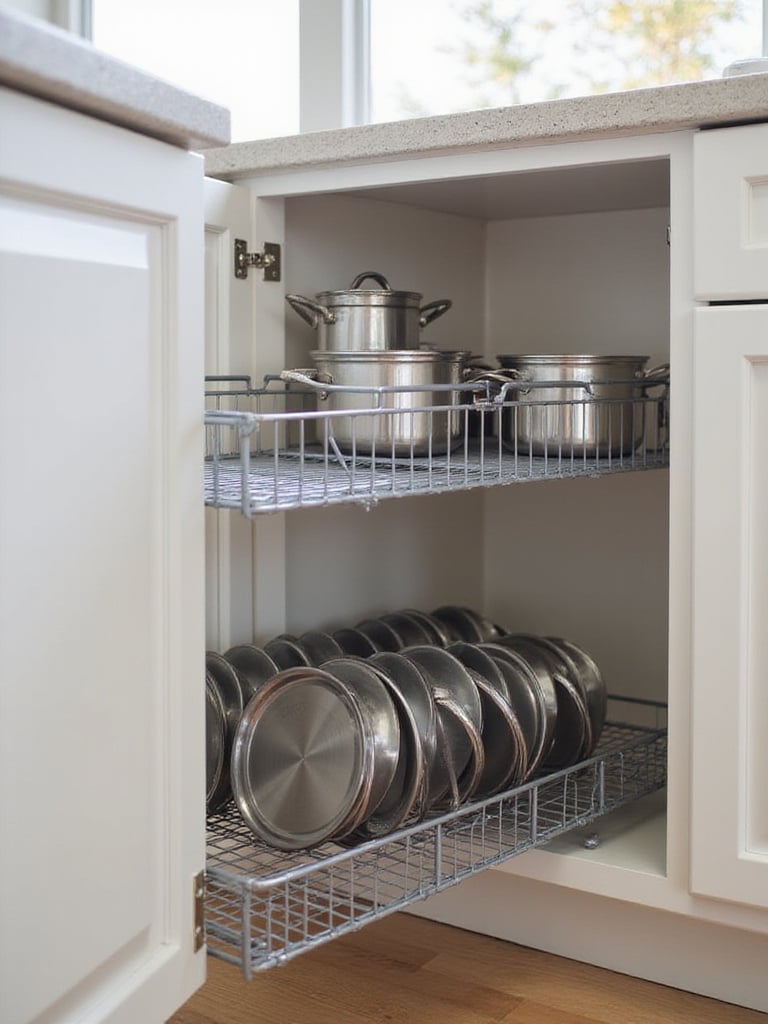
This is where discreet modern hardware becomes a preservationist’s best friend. Custom-built pull-out trays or even high-quality systems from companies like Rev-A-Shelf can be fitted inside those old cabinets. On one project, a Victorian with decidedly non-square cabinets, we built simple wooden pull-out platforms on soft-close glides. From the outside, you see the gorgeous, original paneled door. Open it, and the entire contents of the cabinet slide out to greet you. It preserves the historic exterior while completely revolutionizing the interior function.
Older kitchen drawers are a wild frontier. They’re often enormous, deep, and come in bafflingly non-standard sizes. Tossing in a flimsy plastic organizer from a big-box store just highlights the problem; it slides around in a sea of wasted space. The real solution is to think like a cabinetmaker from the era your home was built.

I learned this on an early project in a 1930s Tudor. The homeowner was an avid baker with a collection of antique rolling pins. We built simple, custom dividers from poplar wood inside a massive, deep drawer. Each pin had its own cradle. Not only did it look beautiful and protect the items, but it used the drawer’s full depth and width. In my experience with heritage conservation, the best solutions are often the simplest. Forget flimsy inserts and create sturdy, built-in dividers that feel like they were always meant to be there.
That sliver of space on the back of a cabinet door is some of the most valuable real estate in a small, historic kitchen. It’s the perfect spot for the little things that create clutter: spice jars, measuring spoons, the roll of foil. Using this space means you don’t have to sacrifice precious counter space or alter the look of your beautiful cabinetry.
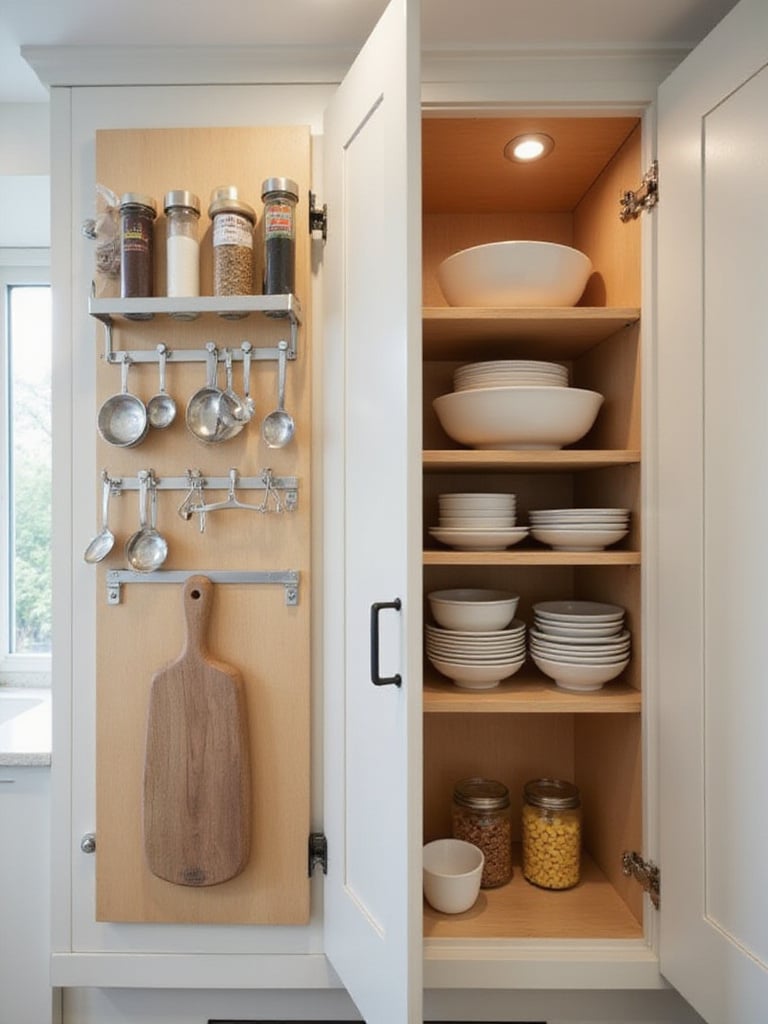
This is where it gets a little tricky, though. Old cabinet doors can be thinner than modern ones, and sometimes they’re made from a single, solid panel of wood you do not want to split. So, choose your organizers wisely. I favor lightweight wooden spice racks or simple metal rails, and I always use screws that are no more than half the thickness of the door. I once saw a client mount a heavy canned-good rack on a beautiful 100-year-old door. A few months later, the door had warped and the hinge screws were pulling out. A heartbreaking and totally avoidable mistake.
Many period homes are blessed with some form of pantry, from a grand butler’s pantry to a humble closet under the stairs. These spaces are a goldmine. More often than not, they contain original shelving—often wonderfully deep and made of thick, sturdy planks. The absolute first rule is: work with what you have.
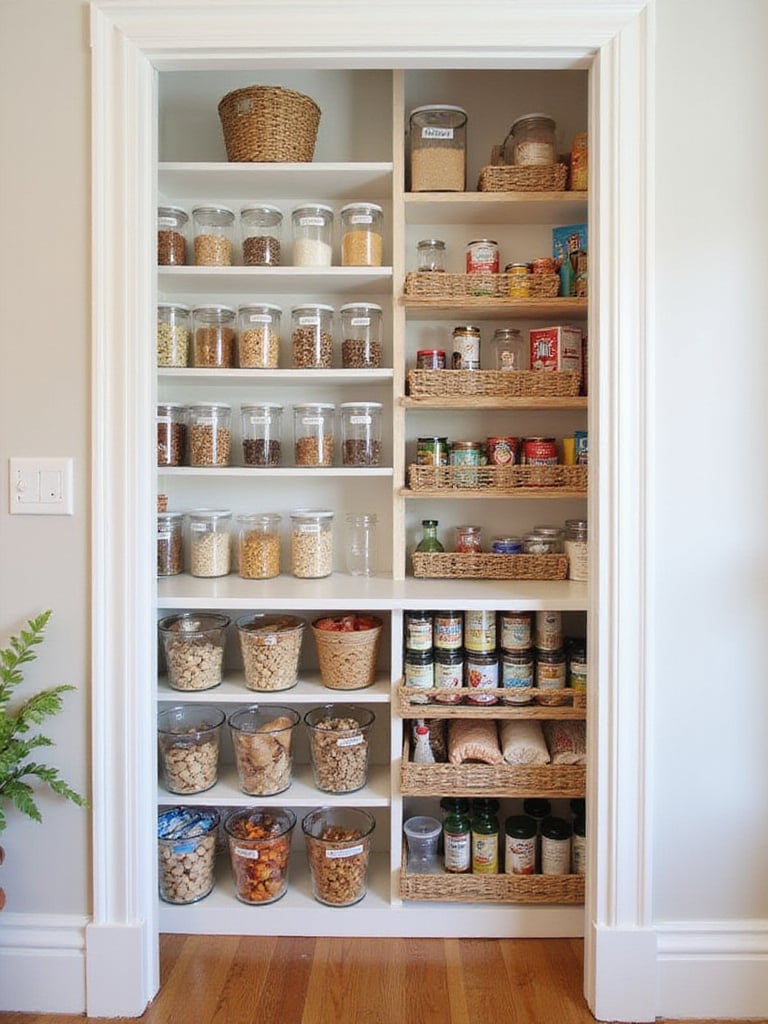
Resist the urge to tear out that shelving for a modern wire system. That wood tells a story; you might even see the faint circles left by a century of canning jars. In my own home, a 1920s Colonial, the pantry has its original beaded-board walls and simple wooden shelves. My “renovation” consisted of a good cleaning, a fresh coat of paint, and a set of glass jars, wooden bins, and woven baskets. It honors the room’s original purpose as a working space, but the new containers bring a sense of order that makes it a joy to use.
“In historical renovation, the pantry is a gift. It’s one of the few places where the original function of the space perfectly aligns with our modern needs. Our job isn’t to reinvent it, but to simply help it do its job better.”
Ah, the dreaded corner cabinet. That dark, awkward abyss where Tupperware lids and obscure wedding-gift appliances go to die. While they feel like a modern problem, the solution can be surprisingly historic. The idea of a rotating shelf—what we now call a Lazy Susan—has been around since the 18th century, so they don’t feel out of place in many period homes.

or a historic application, I recommend looking for wooden models if any part of it will be visible, as plastic can feel jarringly anachronistic. What I tell my clients is that this is one place where function should trump perfect historical accuracy. Getting a well-made, smooth-gliding system installed in that corner will dramatically improve your quality of life in the kitchen. And honestly, no one is going to fault you for making a dark corner usable. It’s a practical solution to a timelessly annoying problem.
Let’s be honest, the space under the sink is a challenge in any house. But in an older home, it can be a true Pandora’s box of odd plumbing configurations, maybe a garbage disposal wedged in at a weird angle, or even the remnants of an old cast-iron trap. My degree in Architectural Conservation taught me to approach such areas with caution and respect for the home’s “systems.”

The goal here is organization without modification. Forget anything that requires drilling or permanent installation. Your best friends are freestanding, removable solutions. I’m a big fan of stacking pull-out drawers that are self-contained units. Tension rods are also brilliant for hanging spray bottles, freeing up the cabinet floor. For a touch of period-appropriate style, find a few enamelware bins or a simple wooden caddy to hold sponges and brushes. It’s about taming the chaos, not re-plumbing the house.
A magnetic knife strip can feel starkly modern, but hear me out. If you have limited counter space—a hallmark of most kitchens built before 1940—getting that chunky knife block off the counter is a huge win. The visual simplicity of a single strip of metal or wood can actually blend in more quietly than a collection of mismatched utensils in a crock.

The key is placement. Don’t slap it right in the middle of a beautifully preserved plaster wall. Instead, find a discreet, functional spot. Mount it on the side of a cabinet near your prep area, or on the tiled or beadboard backsplash behind the stove. I’ve seen this work wonderfully in kitchens from the 1920s onward, where a certain utilitarian efficiency was part of the design ethos. It echoes the practical spirit of a working kitchen, keeping tools close at hand.
This isn’t a clever modern trick; it’s one of the oldest storage solutions in the book. From colonial hearths with simple S-hooks to grand Victorian kitchens with elaborate ceiling-mounted pot racks, hanging cookware has always been a sign of a serious, working kitchen. It frees up an incredible amount of cabinet space and, when done right, adds a ton of warmth and character.
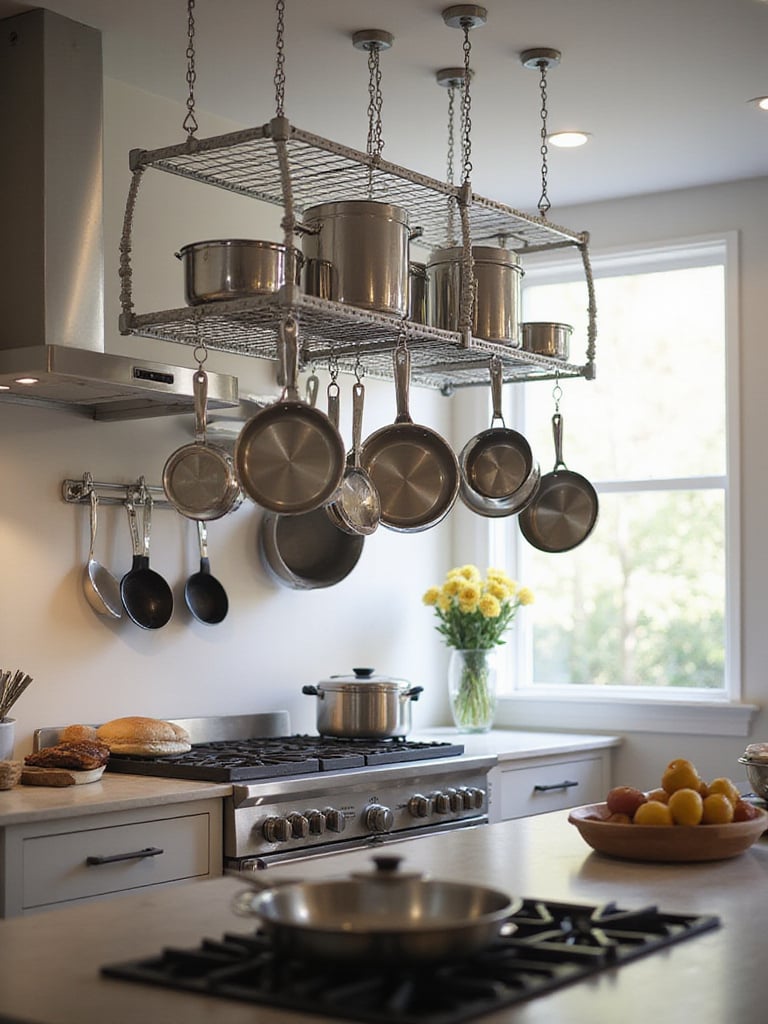
Choosing the right rack is everything. In an early American or Federal-style home, it should be simple, hand-forged iron. For a grander Victorian, polished copper or brass feels right. For a Craftsman home, something with hammered iron and wood details would be perfect. I’ve found that homeowners are often hesitant—worried it will look cluttered. But when you hang your most-used, beautiful pieces (your cast iron skillet, your copper saucepan) near the stove, it doesn’t look like clutter. It looks like you’re ready to cook.
Sometimes the best solution is the one that doesn’t require a single nail or screw. A rolling cart, baker’s table, or small island is the ultimate non-invasive tool for a historic kitchen. It can be your extra counter space for rolling out dough, a coffee station in the morning, or a bar cart when you entertain. And when you need the floor space? You just roll it away.
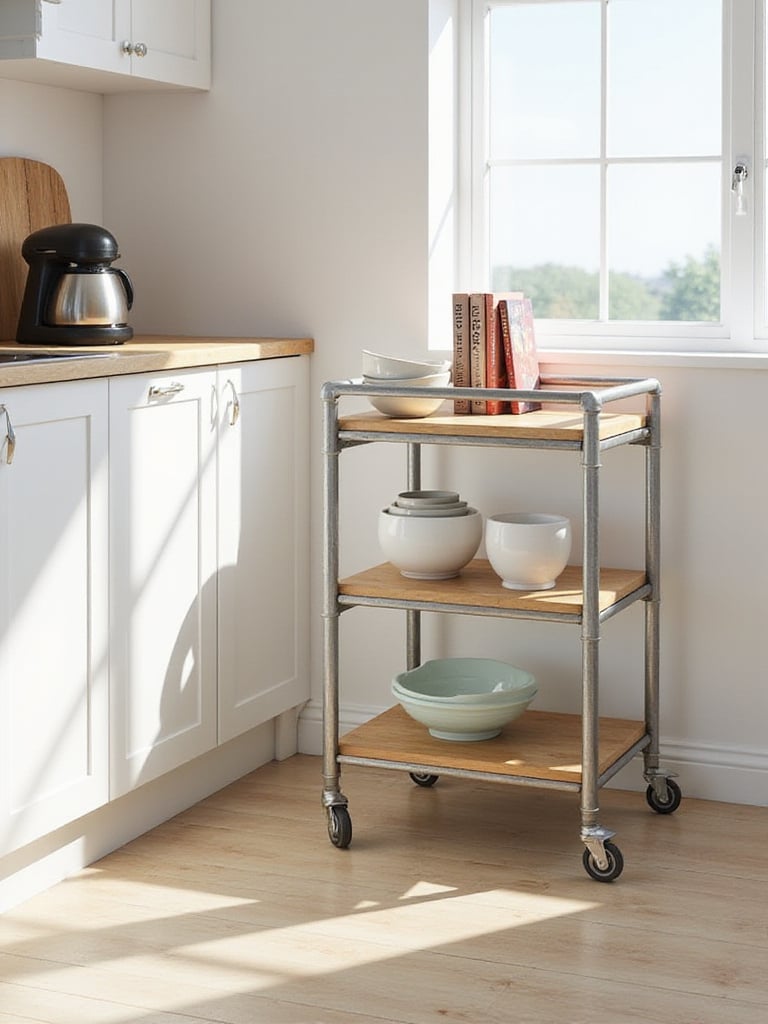
Years of this work have taught me that respecting the original flow of a room is crucial. A permanent island can choke a kitchen designed long before that concept existed. A rolling cart, however, adapts to your needs. Look for one that fits your home’s era—a butcher block top for a farmhouse kitchen, stainless steel for a more industrial or mid-century feel, or a simple painted wood table for a classic 1920s look. It’s pure function and flexibility, a perfect modern amenity that respects the historic shell.
In an old house, decanting your flour, sugar, and pasta into proper containers isn’t just about looking organized for Instagram. Older homes can be draftier and more prone to moisture fluctuations and pests. Good, airtight containers are a practical necessity. And thankfully, the most effective material—glass—is also the most historically timeless.
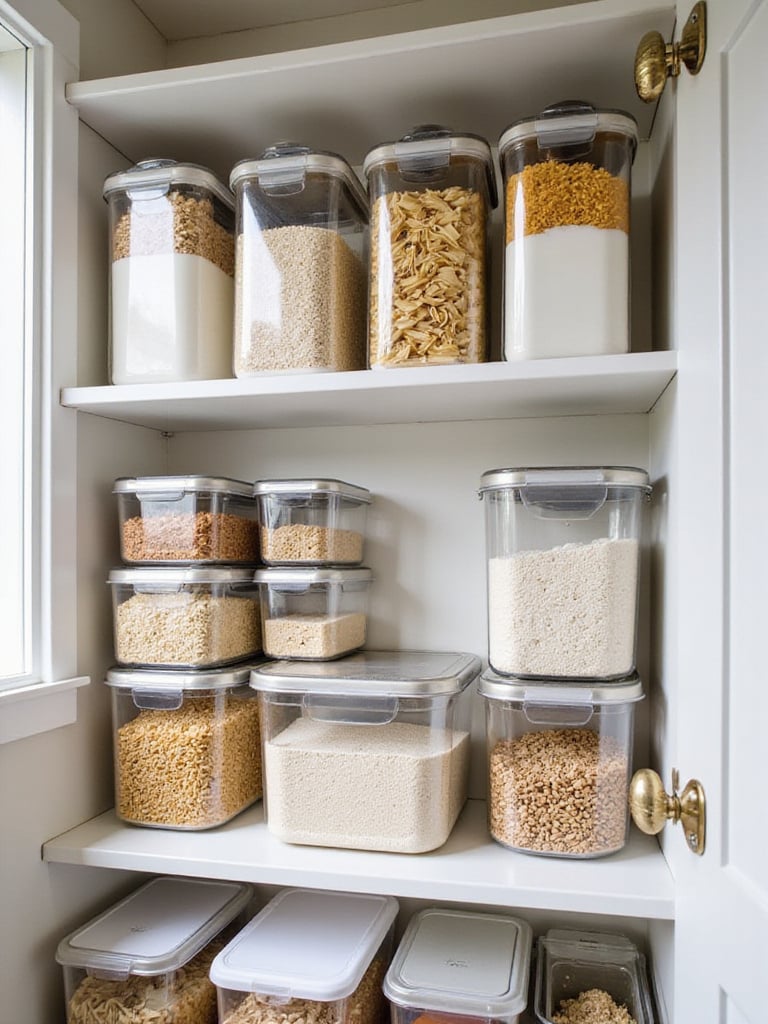
What really gets me is seeing a beautiful, original pantry filled with a chaotic jumble of half-empty plastic bags and mismatched branded boxes. The simple act of switching to a uniform set of glass jars with simple clamp lids or screw-tops instantly creates a sense of calm and order. It feels intentional. In a pre-1950s kitchen, I’d stick with glass, ceramic, or tin. You’re not just organizing; you’re using storage methods that the original owners of your home would have recognized and understood.
The explosion of global cuisines means our spice collections today are exponentially larger than they would have been a century ago. Shoving dozens of tiny jars into a cabinet is a recipe for frustration (and buying your third jar of cumin). While your 1910 kitchen didn’t have a dedicated pull-out spice cabinet, you can add discreet, smart storage.

The most successful integrations I’ve seen are the ones that hide in plain sight. A narrow, multi-tiered rack on the inside of the pantry door is a classic. A custom wooden insert for a shallow drawer is even better. It lays the jars down with labels up, so you can see your whole collection at a glance. It’s a modern solution that feels incredibly satisfying and orderly, all while being completely hidden when the drawer is shut, preserving the kitchen’s vintage aesthetic.
Let’s just acknowledge it: plastic food storage containers and their fugitive lids are a thoroughly modern plague. They don’t belong aesthetically in a historic kitchen, yet we all need them. The challenge is corralling the chaos within the constraints of period cabinetry.
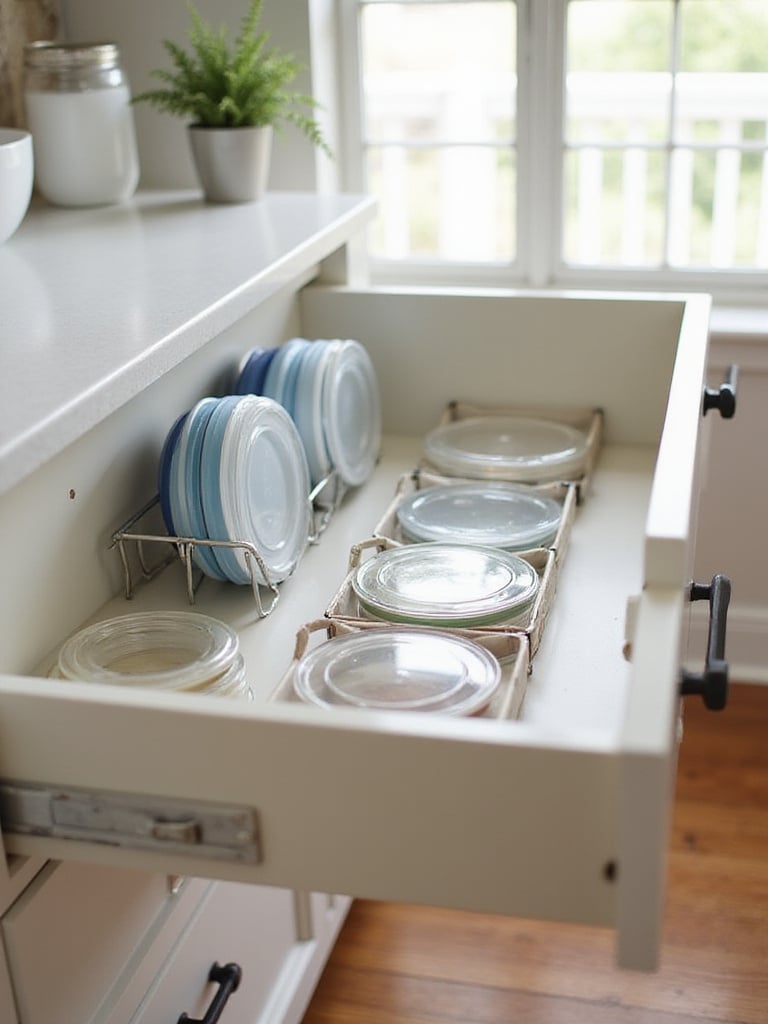
I’ve seen clients have great success repurposing old vinyl record holders or office file organizers inside a deep drawer—they store the lids vertically, like files. Simple tension rods stretched across a drawer can also work wonders to create divided sections. My favorite solution, though, was in an Arts and Crafts kitchen where we took an old wooden plate-drying rack and mounted it inside a deep cabinet. It was the perfect, period-appropriate tool for a very contemporary problem.
If you’re not hanging your pots and pans, you’re likely stacking them in a deep base cabinet. This leads to the inevitable, clattering search for the one pan at the bottom of the pile. This is another area where a simple, non-invasive addition inside an existing cabinet can be a lifesaver.

The solution is to think vertically, even inside a cabinet. Heavy-duty vertical dividers, either store-bought or custom-cut from plywood, allow you to store frying pans, baking sheets, and lids on their sides. Now, instead of unstacking a heavy pile, you just slide one out. It’s a simple concept, but I learned how critical this was when a client with arthritis told me this single change allowed her to keep using her beloved (and heavy) cast-iron skillets. It’s about accessibility and ergonomics, things that matter in any century.
Bakeware is even more awkwardly shaped than cookware. You have muffin tins, cake pans, cookie sheets, and cooling racks—a whole menagerie of flat, wide objects. Before you give up and shove them in the broiler drawer, take a look around your kitchen and adjacent spaces.

Many older homes have little architectural quirks that are perfect for this. Is there a tall, skinny cabinet next to the chimney breast? That’s your bakeware cabinet. A narrow broom closet you could add shelves to? Perfect. I once worked on a farmhouse where the original kitchen had a built-in vertical slot, maybe six inches wide, right next to the stove. It was designed for storing cast-iron griddles and cutting boards. We restored it, and it’s where the new owner keeps all her baking sheets. Look for your home’s original logic first.
Nothing screams “21st century” like a big plastic trash can and a blue recycling bin sitting in the corner of a charming 19th-century kitchen. This is one of the biggest aesthetic challenges. The best solution, by far, is to hide it. Retrofitting a base cabinet with a pull-out trash and recycling system is almost always the right answer.
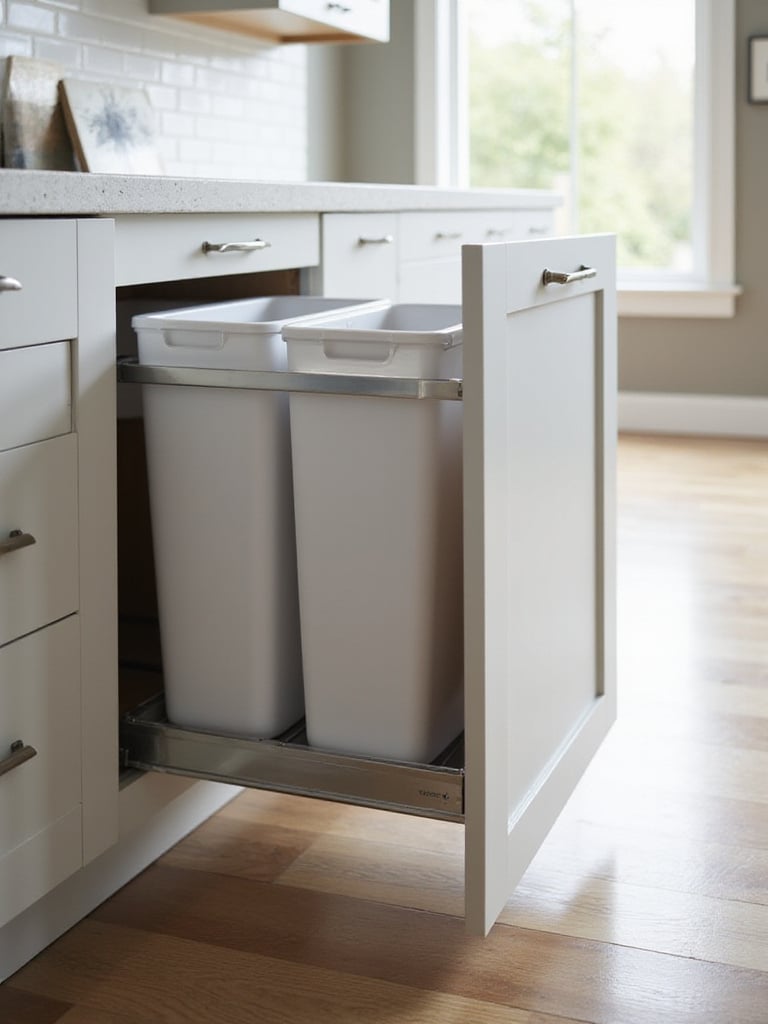
This is a job for a skilled carpenter if you’re dealing with precious original cabinetry. You need to select a cabinet that can be modified with minimal impact—often one that’s already under the sink or in a less prominent location. In a recent project, we converted what was once a wood-storage box next to a hearth into a deep, pull-out recycling center. From my work in heritage conservation, the goal is always to make the modern convenience disappear, so the historic character can shine.
The appliance garage is a modern invention, there’s no way around it. Your home’s original architect certainly didn’t plan a spot for the air fryer. So, if we’re going to introduce one, it must be done with extreme care and craftsmanship, or it will stick out like a sore thumb.

The best appliance garages are not additions, but conversions. Can you sacrifice a section of an existing upper cabinet, add an outlet inside, and fit a retractable door that matches the original cabinetry perfectly? This is the highest form of integration. I tell my clients that the ultimate test is this: if a visitor can’t tell it’s new, we’ve succeeded. It requires matching the wood species, the stain, the hardware, and the construction style. It’s a surgical intervention, not a slap-on solution.
Yes, we’re back to shelves, but for a different reason. Beyond pure storage, open shelving can be an aesthetic tool to make a small or dark historic kitchen feel larger and brighter. Many older kitchens have fewer windows than we’re used to, and a wall of solid upper cabinets—especially dark wood ones—can feel oppressive.
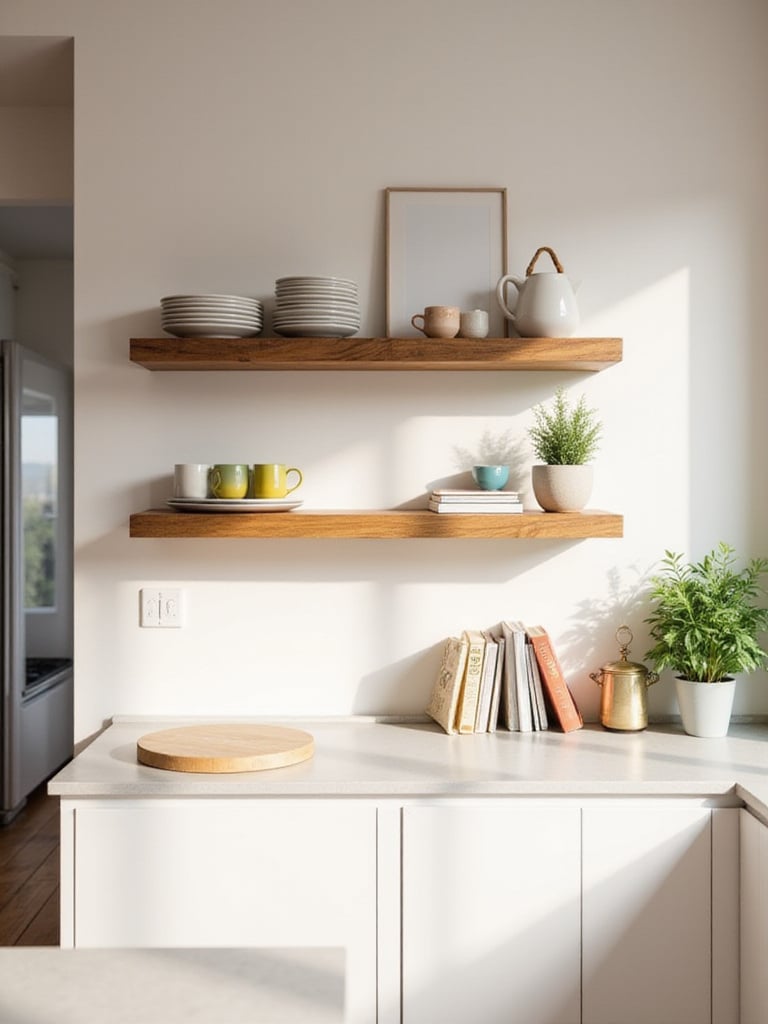
Replacing some of those uppers with open shelving allows light to move more freely through the space. It lets you see the original wall material behind—be it beadboard, old subway tile, or textured plaster. It provides visual relief. What surprises clients most is how this simple change can make their kitchen feel twice as big without moving a single wall. It’s not about clutter; it’s about curating a display of your most beautiful, everyday items and letting the room breathe.
Now, I need to be very specific here. Pegboard is not a one-size-fits-all solution for every historic home. If you live in a Queen Anne Victorian or a Georgian Colonial, just skip this section. It will look terribly out of place. But… if your home is a mid-century ranch, a 1940s cottage, or has an industrial heritage, pegboard can be both historically appropriate and fantastically functional.
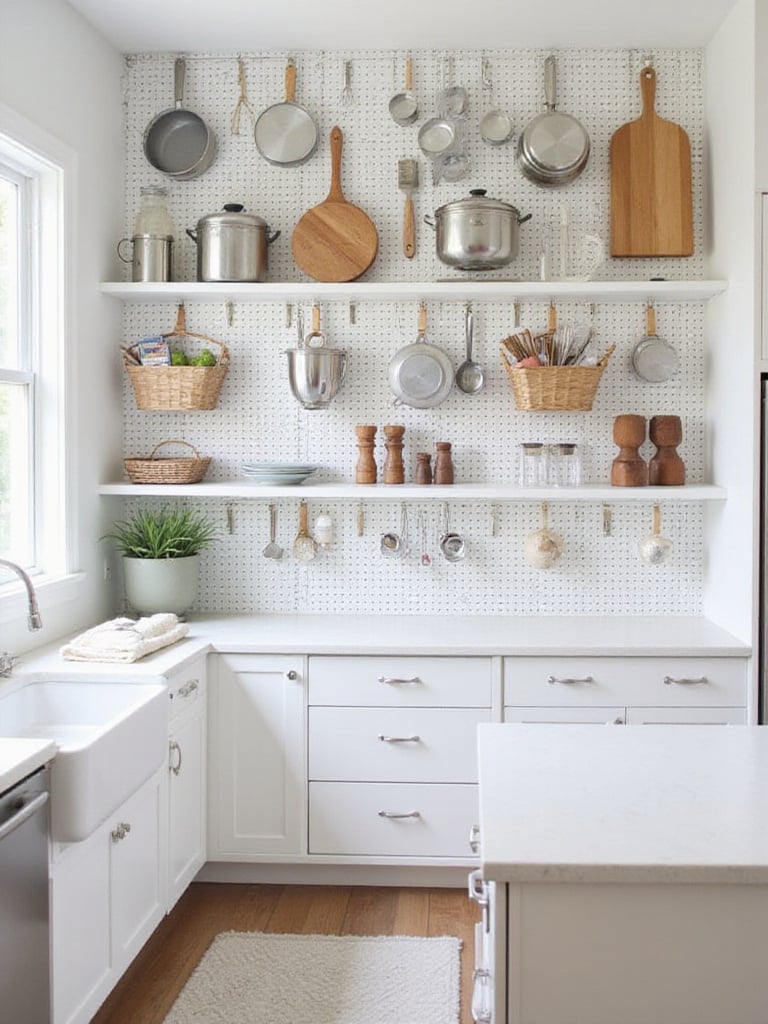
Julia Child made the kitchen pegboard iconic for a reason. It’s infinitely flexible. If you go this route, frame it out with simple wood trim and paint it the same color as the walls to help it blend in. Use it on a secondary, working wall—not as the main focal point. Treat it as the utilitarian surface it is, and it can bring a cool, functionalist vibe that’s right at home in a kitchen from 1950.
Every kitchen needs a spot for cleaning supplies. The historical default was often a designated “broom closet” or utility closet, sometimes in a back hallway or as part of a larger pantry. If your house still has one of these, you’ve hit the jackpot! Your job is simply to restore its original function with better organization.
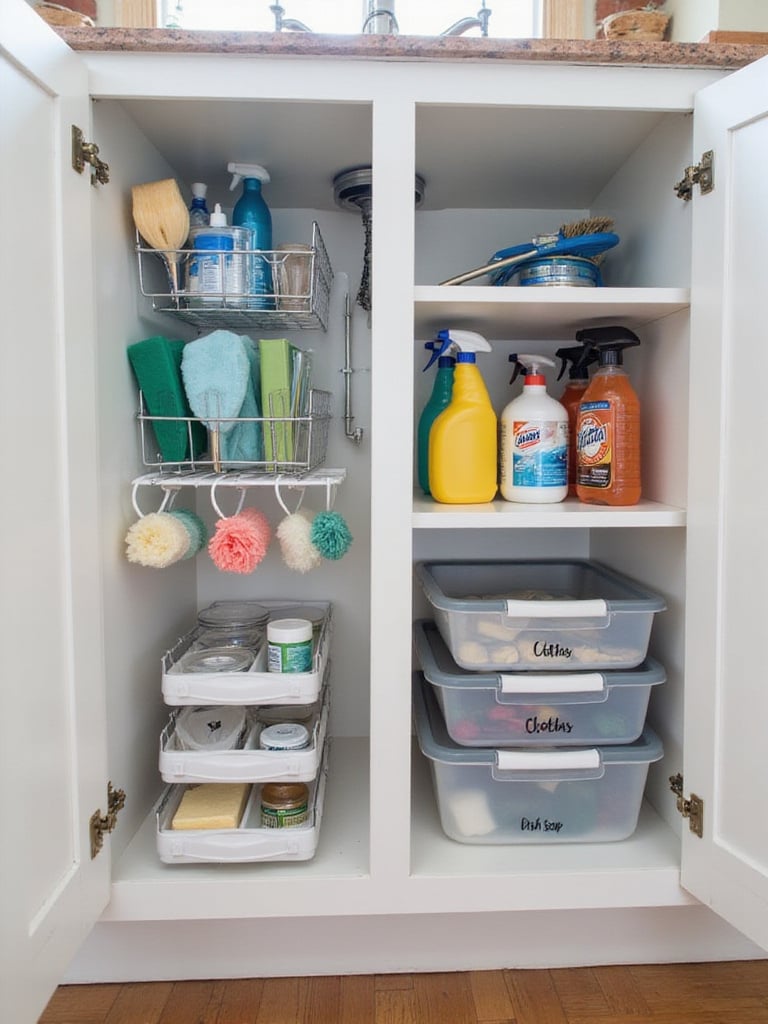
If you don’t have that feature, the under-sink cabinet is the next logical place. Again, think in terms of simple, period-appropriate materials for any visible organizers. A sturdy wooden caddy you can pull out is more at home than a brightly colored plastic bucket. It’s a small detail, but these choices, when added up, create a cohesive feel that respects the home’s age.
The modern “kitchen work triangle” concept isn’t modern at all. It’s just a new name for the logic that has governed kitchen design for centuries. A well-functioning historic kitchen already had zones: a baking area near the pantry (where flour and sugar were kept), a prep and washing area near the sink, and a cooking area near the hearth or stove.
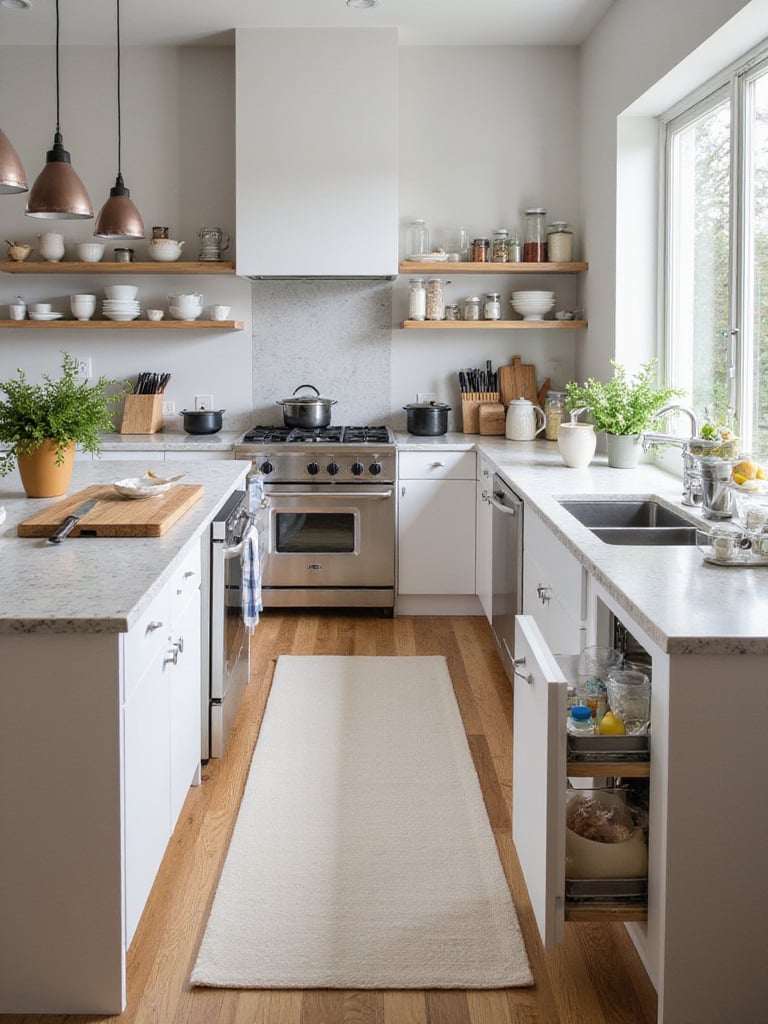
Your job isn’t to impose a new layout, but to rediscover the old one and enhance it with modern storage. Group all your baking pans and measuring cups in the cabinets within the original baking zone. Keep knives and cutting boards near the sink and prep area. By organizing your stuff according to the kitchen’s inherent, historical flow, you create a space that feels intuitive and efficient, a seamless conversation between past and present.
In the end, creating a functional kitchen in a historic home is a delicate dance. It’s about listening to the house, respecting its bones, and gently, thoughtfully helping it adapt to a new century. Not about finding the one “right” answer, but about making a series of small, informed choices that add up to a kitchen that doesn’t just look beautiful, but feels right. It’s a space that holds your history, and helps you make new memories, one meal at a time.